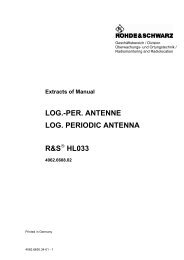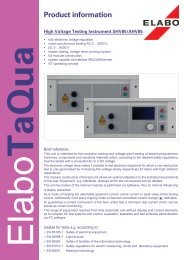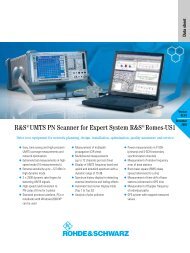Glossary of Video Terms and Acronyms - Isotest
Glossary of Video Terms and Acronyms - Isotest
Glossary of Video Terms and Acronyms - Isotest
Create successful ePaper yourself
Turn your PDF publications into a flip-book with our unique Google optimized e-Paper software.
<strong>Video</strong> <strong>Terms</strong> <strong>and</strong> <strong>Acronyms</strong><br />
<strong>Glossary</strong><br />
2K – A film image scanned into a computer file at a resolution <strong>of</strong> 2048<br />
horizontal pixels per line.<br />
2T Pulse – See the discussion on Sine-Squared Pulses.<br />
3-Perf – A concept for saving money on film stock by shooting each<br />
35 mm frame in an area covered by three perforations rather than four.<br />
The savings is more than enough to compensate for switching from 24<br />
frames per second to 30. Three-perf naturally accommodates a 1.78:1<br />
(16:9) aspect ratio <strong>and</strong> can be easily masked to the 1.85:1 common in<br />
U.S. movie theaters. It changes the shoot-<strong>and</strong>-protect concept <strong>of</strong> using<br />
theatrical film on television, however, from one in which the protected area<br />
is extended vertically to one in which the shooting area is reduced<br />
horizontally.<br />
3.579545 MHz – The frequency <strong>of</strong> the NTSC color subcarrier.<br />
3:2 Pull Down – a) The technique used to convert 24 frames per second<br />
film to 30 frames per second video. Every other film frame is held for three<br />
video fields resulting in a sequence <strong>of</strong> 3 fields, 2 fields, 3 fields, 2 fields,<br />
etc. b) A frame cadence found in video that has been telecined or converted<br />
from film to video. This cadence is produced because the frame rates<br />
for film <strong>and</strong> video are different. During the process <strong>of</strong> compression, some<br />
compression hardware recognizes this cadence <strong>and</strong> can further compress<br />
video because <strong>of</strong> it. Material which is video to start with gains no extra<br />
compression advantage. Material edited after being telecined may not gain<br />
a compression advantage.<br />
30 Hz HDTV Bitstream – A bitstream which contains only Main Pr<strong>of</strong>ile,<br />
High Level (or simpler) video at 24000/1001, 24, 30000/1001, 30,<br />
60/1001 or 60 Hz frame rates.<br />
30 Hz HDTV IRD – An IRD (Integrated Receiver Decoder) that is capable <strong>of</strong><br />
decoding <strong>and</strong> displaying pictures based on nominal video frame rates <strong>of</strong><br />
24000/1001, 24, 30000/1001, 30, 60/1001 or 60 Hz from MPEG-2 Main<br />
Pr<strong>of</strong>ile, High Level bitstreams, in addition to providing the functionality <strong>of</strong> a<br />
30 Hz SDTV IRD.<br />
30 Hz SDTV Bitstream – A bitstream which contains only Main Pr<strong>of</strong>ile,<br />
Main Level video at 24000/1001, 24, 30000/1001 or 30 Hz frame rate.<br />
30 Hz SDTV IRD – An IRD (Integrated Receiver Decoder) which is capable<br />
<strong>of</strong> decoding <strong>and</strong> displaying pictures based on a nominal video frame rate <strong>of</strong><br />
24000/1001 (approximately 23,98), 24, 3000/1001 (approximately 29,97)<br />
or 30 Hz from MPEG-2 Main Pr<strong>of</strong>ile at Main Level bitstreams.<br />
30 Frames Per Second – Frame rate <strong>of</strong> NTSC prior to color. Frame rate <strong>of</strong><br />
the ATSC/SMPTE HDEP st<strong>and</strong>ard. A potential new film st<strong>and</strong>ard.<br />
3D (Three Dimensional) – Either as in stereoscopic television (NHK has<br />
suggested alternating 3DTV transmissions with HDTV), or more <strong>of</strong>ten, when<br />
referring to ATV, relating to the three dimensions <strong>of</strong> the spatio-temporal<br />
spectrum: horizontal, vertical, <strong>and</strong> time.<br />
3D Axis (Menu) – The 3D function that moves the image away from the<br />
center <strong>of</strong> rotation. The image can be moved along, or <strong>of</strong>f any <strong>of</strong> the three<br />
axes.<br />
3D Space – Three dimensional space is easily imagined by looking at a<br />
corner <strong>of</strong> a rectangular room. The corner is called the origin. Each edge<br />
leaving from the origin (there are three <strong>of</strong> them) is called an axis. Each axis<br />
extends infinitely in two directions (up/down, left/right, <strong>and</strong> front/back).<br />
2 www.tektronix.com/video_audio<br />
Imagine laying long measuring sticks on each axis. These are used to<br />
locate specific points in space. On the Cubicomp, or any other graphics<br />
systems, the yardsticks are not infinitely long, <strong>and</strong> 3D space on these<br />
devices is not infinite; it is more like an aquarium.<br />
3XNTSC – A Zenith proposal for an HDEP scheme that would use three<br />
times as many scanning lines as NTSC (1575), but would otherwise retain<br />
NTS characteristics. It is said to allow easy st<strong>and</strong>ards conversion to 525or<br />
625-scanning line systems <strong>and</strong> to accept material shot in 1125 scanning<br />
lines in a 16:9 aspect ratio without difficulty. 3XNTSC would have<br />
1449 active scanning lines, 2:1 interlace, a 4:3 aspect ratio, <strong>and</strong> a b<strong>and</strong>width<br />
<strong>of</strong> 37.8 MHz.<br />
4:1:1 – 4:1:1 indicates that Y' has been sampled at 13.5 MHz, while Cb<br />
<strong>and</strong> Cr were each sampled at 3.375 MHz. Thus, for every four samples <strong>of</strong><br />
Y', there is one sample each <strong>of</strong> Cb <strong>and</strong> Cr.<br />
4:2:0 – A sampling system used to digitize the luminance <strong>and</strong> color difference<br />
components (Y, R-Y, B-Y) <strong>of</strong> a video signal. The four represents the<br />
13.5 MHz sampling frequency <strong>of</strong> Y, while the R-Y <strong>and</strong> B-Y are sampled at<br />
6.75 MHz – effectively between every other line only.<br />
4:2:2 – a) A commonly used term for a component digital video format.<br />
The details <strong>of</strong> the format are specified in the CCIR-601 st<strong>and</strong>ard document.<br />
The numerals 4:2:2 denote the ratio <strong>of</strong> the sampling frequencies <strong>of</strong><br />
the single luminance channel to the two color difference channels. For<br />
every four luminance samples, there are two samples <strong>of</strong> each color difference<br />
channel. b) ITU-R BT.601 digital component waveform sampling st<strong>and</strong>ard<br />
where the luminance signal is sampled at the rate <strong>of</strong> 13.5 MHz, <strong>and</strong><br />
each <strong>of</strong> the color difference signals, (Cr <strong>and</strong> Cb) are sampled at the rate <strong>of</strong><br />
6.25 MHz each. This results in four samples <strong>of</strong> the luminance signal for<br />
each two samples <strong>of</strong> the color difference signals. See ITU-R BT.601-2.<br />
10 Bit<br />
Y Sample<br />
10 Bit<br />
C r Sample<br />
10 Bit<br />
Y Sample<br />
10 Bit<br />
C b Sample<br />
10 Bit<br />
Y Sample<br />
10 Bit<br />
C r Sample<br />
10 Bit<br />
Y Sample<br />
10 Bit<br />
C b Sample<br />
4:2:2p (Pr<strong>of</strong>essional Pr<strong>of</strong>ile) – 4:2:2p refers to a higher quality, higher<br />
bitrate encoding designed for pr<strong>of</strong>essional video usage. It allows multiple<br />
encodings/decodings before transmission or distribution.<br />
4:2:2:4 – Same as 4:2:2 with the addition <strong>of</strong> a key channel sampled at the<br />
same frequency as the luminance.<br />
4:4:4 – A sampling ratio that has equal amounts <strong>of</strong> the luminance <strong>and</strong><br />
both chrominance channels.<br />
4:4:4:4 – Same as 4:2:2 with the addition <strong>of</strong> a key channel, <strong>and</strong> all channels<br />
are sampled at the same frequency as the luminance.<br />
45 Mbps – Nominal data rate <strong>of</strong> the third level <strong>of</strong> the hierarchy <strong>of</strong> ISDN in<br />
North America. See also DS3.<br />
4fsc – Composite digital video as used in D2 <strong>and</strong> D3 VTRs. St<strong>and</strong>s for four<br />
times the frequency <strong>of</strong> subcarrier, which is the sampling rate used. In<br />
NTSC, 4FSC is 14.3 MHz <strong>and</strong> in PAL it is 17.7 MHz.<br />
4K – A film image scanned into a computer file at a resolution <strong>of</strong> 4096<br />
horizontal pixels per line. 4K is considered to be a full-resolution scan <strong>of</strong><br />
35 mm film.





